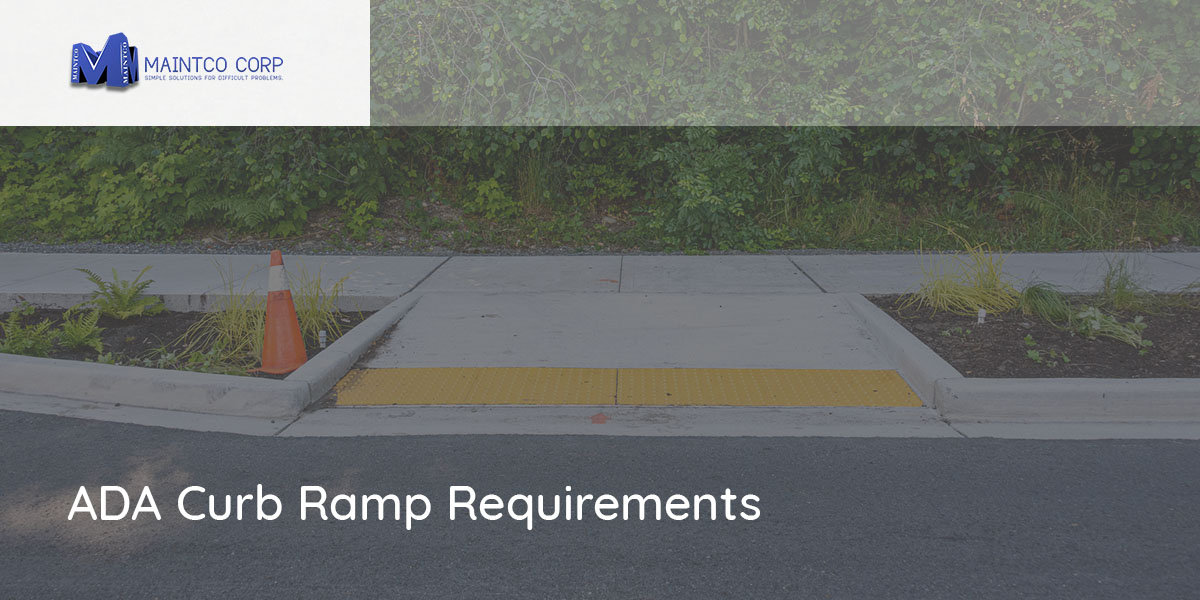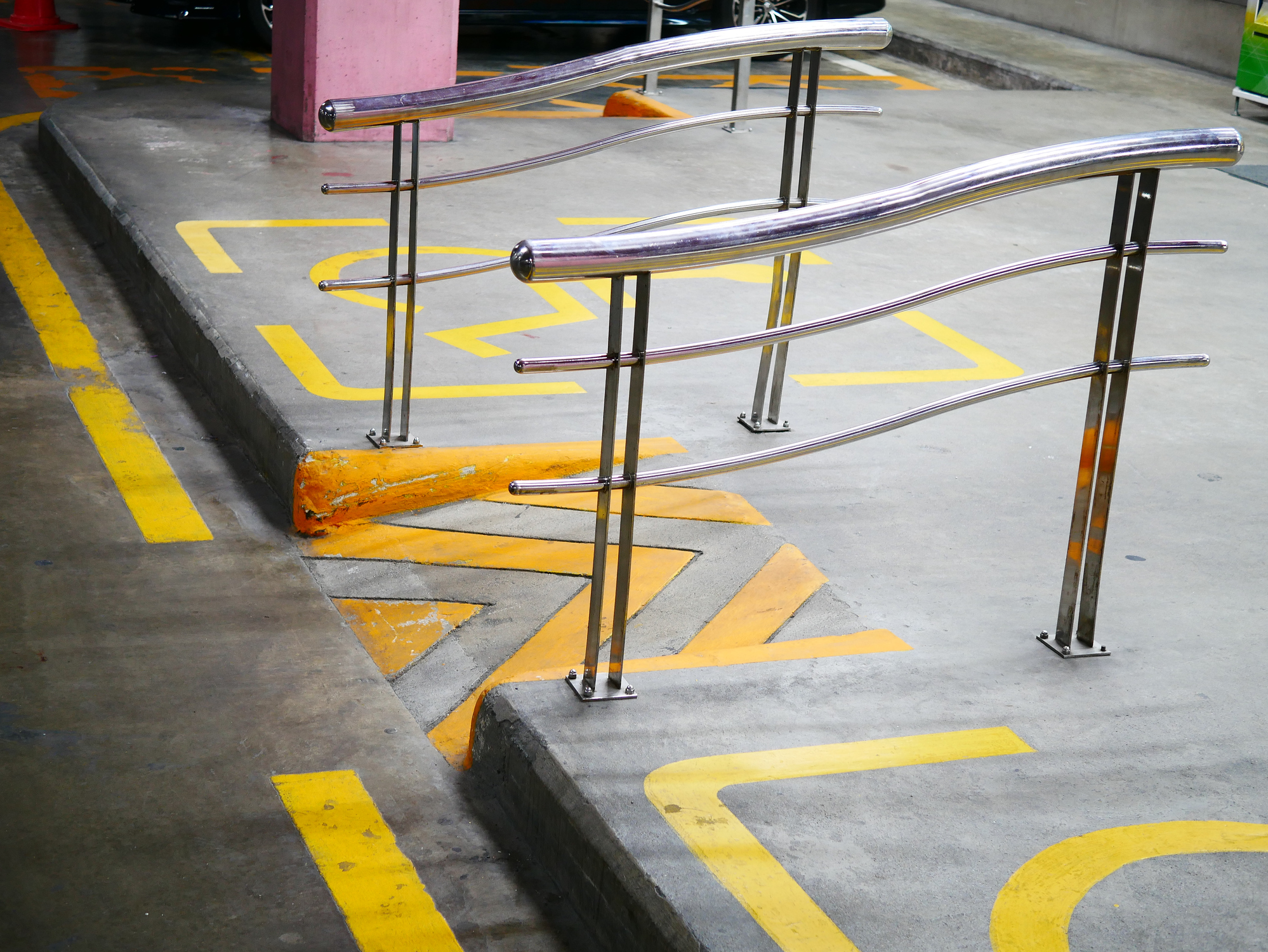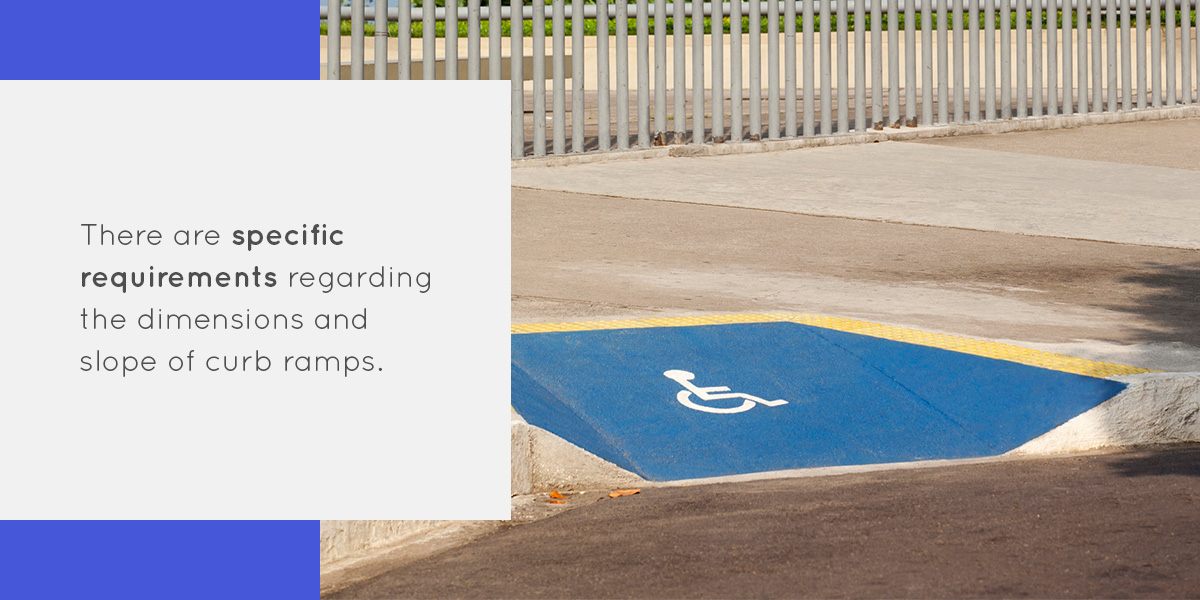ADA Curb Ramp Requirements
Posted on: May 16, 2022 in ADA ComplianceShare:

Ramps play a vital role in making sidewalks and other pedestrian crossings accessible. Because of their importance, it’s essential to ensure that your ramps adhere to the Americans with Disabilities Act (ADA) guidelines. The ADA, first signed into law in July 1990, is one of the United States’ most comprehensive pieces of civil rights legislation.
California is the most ADA litigious state and even a false claim can have devastating consequences for a business. Building ADA-compliant curb ramps will help your business avoid costly litigations and make your company as accessible as possible.
Check out this guide on ADA curb ramp requirements in California to see how your business can become more ADA-compliant.
Importance of an ADA-Compliant Curb Ramp
A curb ramp cuts through or builds up to the height of the curb, providing a safe, accessible transition from road to sidewalk. Creating ADA-compliant sidewalk ramps leading up to your front door gives everyone the ability to access your business.
The Pieces of Curb Ramps
A curb ramp is any small ramp that builds up to a curb’s height or cuts through the curb as an extension of the sidewalk. Before we jump in, it’ll be helpful to also know the different types and parts of curb ramps:
- Built-up ramps: Built-up curb ramps are perpendicular to the sidewalk and build up to the height of the curb.
- Traditional ramps: Traditional curb ramps cut into the sidewalk. Rather than building a separate ramp perpendicular to the sidewalk, the sidewalk slopes into the ramp as a single piece.
- Flared sides: Flared sides widen the curb ramp. The ramp will have diagonal edges that start at the top of the rank and go outward towards the street.
- Returned curbs: The ramp has vertical edges rather than diagonal with returned curbs.
- Running slope: The running slope measures the ramp’s degree of slant moving in the walking direction of the ramp.
- Cross slope: The cross slope measures the slant of the ramp from side to side.
- Gutter: The gutter is where the road connects to the curb.
Are ADA Curb Ramps Required in California?
Both the ADA and Title 24 of the California Code of Regulations require curb ramps in California. These regulations establish the baseline requirements for curbs, sidewalks, structures or buildings made open to the public, though local governments may include additional requirements.
Where Can Built-Up Curb Ramps Be Used?
Some curb ramps function as an extension of the sidewalk — a person can step from the ramp to the sidewalk without changing direction. Built-up curbs, however, are typically separate pieces set perpendicular to the sidewalk.
The ADA requires curb ramps on accessible routes in areas where the elevation changes more than 1/2 inch. However, there are some restrictions on where built-up curb ramps are allowed.
Built-up curbs cannot interfere with traffic or be in the way of cars. They also cannot project into parking spaces.
Curb Ramp Requirements in California
The ADA has dimension requirements for curb ramps that make them as safe and accessible as possible.
Dimension and Slope Requirements of Curb Ramps
There are specific requirements regarding the dimensions and slope of curb ramps. ADA curb ramp standards include:
- Width: Ramps must be at least 36 inches wide.
- Running slope: Slopes of ramps constructed after January 26, 1991, must be less than 8.33%. If the ramp was changed after this date, slopes must not exceed 10% for a 6-inch rise or 12.5% for a 3-inch rise.
- Cross slope: The cross slope is the slope moving across the ramp from side to side. The cross slope must not exceed 2%.
- Gutter slope: The gutter may slope up to 5% toward the curb ramp.
- Flared sides slope: If applicable, the slope of flared sides can’t exceed 8.33% when there are 48 inches or less between the top of the ramp and the opposite side of the sidewalk.
- Built-up curbs: The flared sides of built-up curbs should be 10% or less. Otherwise, they should be paired with edge protection and handrails.
- Transitions: The ramp’s transitions to the gutter, street and sidewalk should be level, without any abrupt changes in height.
ADA Requirements for Landings
ADA sidewalk requirements also cover landings for curb ramps:
- The landing at the top of the ramp must be at least 36 inches long to let pedestrians pass the ramp without stepping onto it.
- The top landing must be at least as wide as the ramp before including any flared sides.
- When a top landing is present, the slope of the ramp’s side flares can’t exceed 10%.
- If a curb ramp doesn’t have sufficient space for a top landing, the ramp must include side flares with a maximum slope of 8.33% to accommodate wheelchair use.
Requirements for Intersections
ADA curb ramps for intersections must be contained within the marked crosswalk. Flared sides are not included in this measurement. ADA-compliant pedestrian crossings must also be labeled with detectable warnings.
Detectable Warning Systems for Curb Ramps
You’ve probably seen detectable warnings on sidewalks before — dome-shaped bumps that extend the entire width of the ramp. These bumps appear in a contrasting color to the rest of the sidewalk or street. There are specific requirements to make detectable warnings ADA compliant as well.
The ADA and the U.S. Department of Transportation (DOT) have different requirements for detectable warnings. ADA standards require detectable warnings to extend the entire length and width of the curb ramp. Under Title II of the ADA, the DOT requires detectable warning systems that extend the whole width of the ramp but need only cover the 24 inches closest to the street. They also must have:
- Center-to-center spacing between 1.6 inches and 2.4 inches.
- A base diameter between 0.9 inches and 1.4 inches.
- A top diameter between 50% and 65% of the base diameter.
- A height of 0.2 inches.
Where Are Detectable Warnings Required on Curb Ramps?
According to the ADA website, detectable warnings are supposed to serve a similar purpose as stop signs, signaling the presence of a ramp to individuals who are blind or have low vision. Detectable warnings are visual cues, and their bumpy texture can also serve as a tactile cue.
In addition to on curb ramps, detectable warnings are required in bus stations, subways and other public transportation pick-up and drop-off locations.
Choose Maintco Corp for Your ADA-Compliant Curb Ramps
At Maintco Corp, we provide comprehensive services for ADA-compliant ramps. Our consulting services can help you ensure you’re complying with state law to the best of your ability. We have more than 25 years of success in construction and maintenance in various industries. We’re committed to providing you and your business with reliable assistance complying with ADA standards.
For more information, contact us today or call us at 818-276-6300.






